人教版七年级英语下册各单元知识点汇总
期末复习人教版英语七年级下册单元重点知识点语法汇总
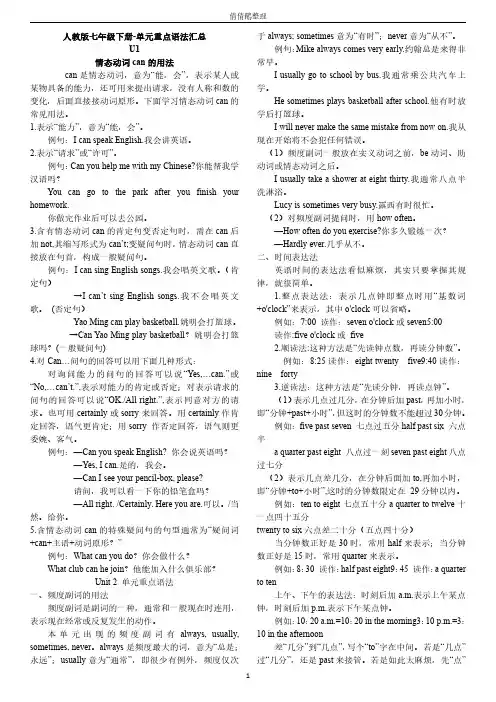
人教版七年级下册-单元重点语法汇总U1情态动词can的用法can是情态动词,意为“能,会”,表示某人或某物具备的能力,还可用来提出请求,没有人称和数的变化,后面直接接动词原形。
下面学习情态动词can的常见用法。
1.表示“能力”,意为“能,会”。
例句:I can speak English.我会讲英语。
2.表示“请求”或“许可”。
例句:Can you help me with my Chinese?你能帮我学汉语吗?You can go to the park after you finish your homework.你做完作业后可以去公园。
3.含有情态动词can的肯定句变否定句时,需在can后加not,其缩写形式为can’t;变疑问句时,情态动词can直接放在句首,构成一般疑问句。
例句:I can sing English songs.我会唱英文歌。
(肯定句)→I can’t sing English songs.我不会唱英文歌。
(否定句)Yao Ming can play basketball.姚明会打篮球。
→Can Yao Ming play basketball?姚明会打篮球吗?(一般疑问句)4.对Can…问句的回答可以用下面几种形式:对询问能力的问句的回答可以说“Yes,…can.”或“No,…can’t.”,表示对能力的肯定或否定;对表示请求的问句的回答可以说“OK./All right.”,表示同意对方的请求。
也可用certainly或sorry来回答。
用certainly作肯定回答,语气更肯定;用sorry作否定回答,语气则更委婉、客气。
例句:—Can you speak English?你会说英语吗?—Yes,I can.是的,我会。
—Can I see your pencil-box,please?请问,我可以看一下你的铅笔盒吗?—All right./Certainly.Here you are.可以。
人教版七年级下册英语各单元知识点归纳
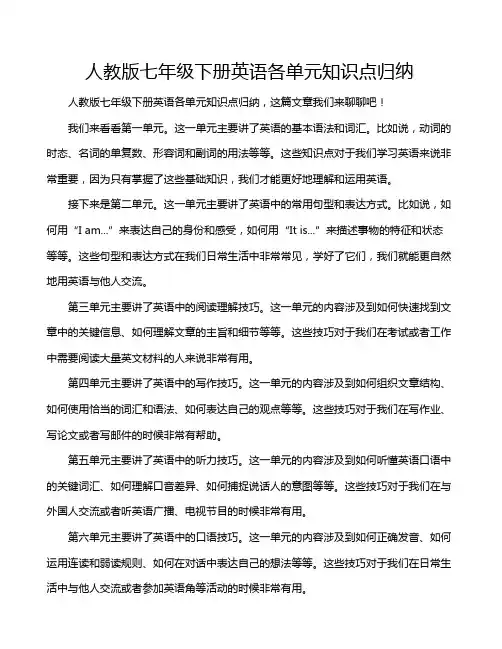
人教版七年级下册英语各单元知识点归纳人教版七年级下册英语各单元知识点归纳,这篇文章我们来聊聊吧!我们来看看第一单元。
这一单元主要讲了英语的基本语法和词汇。
比如说,动词的时态、名词的单复数、形容词和副词的用法等等。
这些知识点对于我们学习英语来说非常重要,因为只有掌握了这些基础知识,我们才能更好地理解和运用英语。
接下来是第二单元。
这一单元主要讲了英语中的常用句型和表达方式。
比如说,如何用“I am...”来表达自己的身份和感受,如何用“It is...”来描述事物的特征和状态等等。
这些句型和表达方式在我们日常生活中非常常见,学好了它们,我们就能更自然地用英语与他人交流。
第三单元主要讲了英语中的阅读理解技巧。
这一单元的内容涉及到如何快速找到文章中的关键信息、如何理解文章的主旨和细节等等。
这些技巧对于我们在考试或者工作中需要阅读大量英文材料的人来说非常有用。
第四单元主要讲了英语中的写作技巧。
这一单元的内容涉及到如何组织文章结构、如何使用恰当的词汇和语法、如何表达自己的观点等等。
这些技巧对于我们在写作业、写论文或者写邮件的时候非常有帮助。
第五单元主要讲了英语中的听力技巧。
这一单元的内容涉及到如何听懂英语口语中的关键词汇、如何理解口音差异、如何捕捉说话人的意图等等。
这些技巧对于我们在与外国人交流或者听英语广播、电视节目的时候非常有用。
第六单元主要讲了英语中的口语技巧。
这一单元的内容涉及到如何正确发音、如何运用连读和弱读规则、如何在对话中表达自己的想法等等。
这些技巧对于我们在日常生活中与他人交流或者参加英语角等活动的时候非常有用。
第七单元主要讲了英语中的文化知识。
这一单元的内容涉及到英美文化的差异、英国历史和地理等方面的知识。
了解这些知识可以帮助我们更好地理解和运用英语,同时也可以增进我们对不同文化的理解和尊重。
人教版七年级下册英语各单元知识点归纳是非常重要的一本书,它涵盖了许多我们在学习英语过程中需要掌握的基础知识和技能。
人教版人教版七年级下册英语知识点复习(完整版)
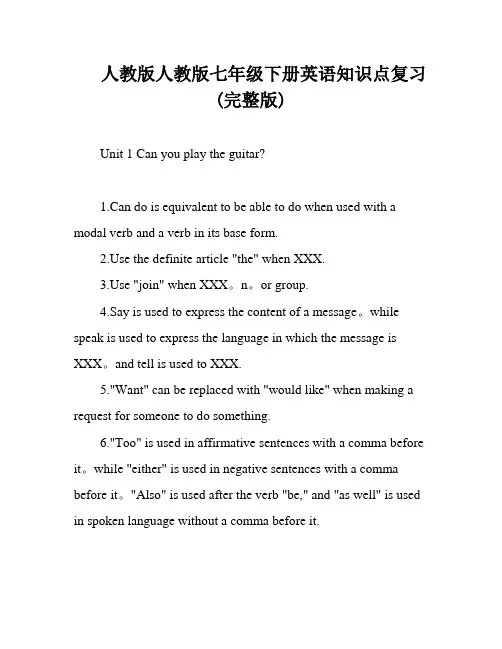
人教版人教版七年级下册英语知识点复习(完整版)Unit 1 Can you play the guitar?1.Can do is equivalent to be able to do when used with a modal verb and a verb in its base form.e the definite article "the" when XXX.e "join" when XXX。
n。
or group.4.Say is used to express the content of a message。
while speak is used to express the language in which the message is XXX。
and tell is used to XXX.5."Want" can be replaced with "would like" when making a request for someone to do something.6."Too" is used in affirmative sentences with a comma before it。
while "either" is used in negative sentences with a comma before it。
"Also" is used after the verb "be," and "as well" is used in spoken language without a comma before it.7."Be good at" is used to XXX or activity。
人教版七年级英语下册单元知识点总结(全册)
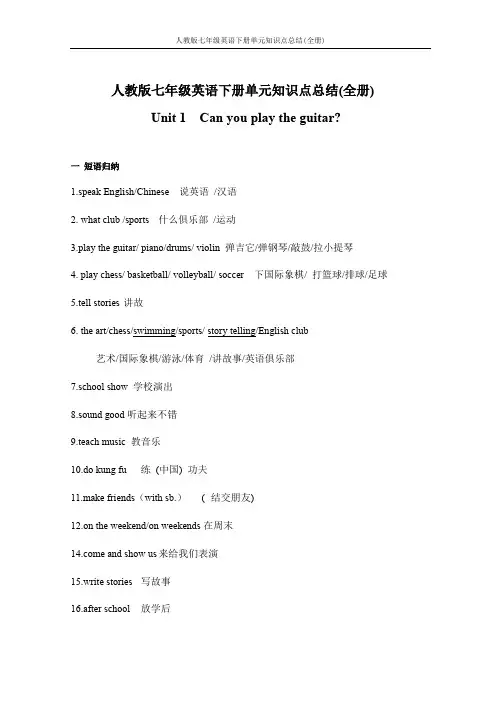
人教版七年级英语下册单元知识点总结(全册)Unit 1 Can you play the guitar?一短语归纳1.speak English/Chinese 说英语/汉语2. what club /sports什么俱乐部/运动3.play the guitar/ piano/drums/ violin 弹吉它/弹钢琴/敲鼓/拉小提琴4. play chess/ basketball/ volleyball/ soccer 下国际象棋/ 打篮球/排球/足球5.tell stories讲故6. the art/chess/swimming/sports/ story telling/English club艺术/国际象棋/游泳/体育/讲故事/英语俱乐部7.school show 学校演出8.sound good听起来不错9.teach music 教音乐10.do kung fu练(中国) 功夫11.make friends(with sb.)(结交朋友)12.on the weekend/on weekends在周末e and show us来给我们表演15.write stories写故事16.after school放学后17.English-speaking students说英语的学生18.play games 做游戏19.the Students’ Sports Center学生运动中心20.at the old people’s home在老人之家21.be in our school music festival 参加学校音乐节22.jion the music club加入音乐俱乐部二用法集萃1. play +棋类/球类下……棋,打……球2. play the +乐器弹/拉……乐器3. be good at doing sth.擅长做某事be good for.. 对… 有好处be good /kind to … 对… 友好4. be good with sb. 和某人相处地好; 善于应付(处理)…5. need(sb./sth.)to do… 需要(某人/某物)做….6. can + 动词原形能/会做某事7. a little + 不可数名词: 一点儿……9. like to do sth.或like doing sth. 喜欢做某事10.want to do…想做……11.What about…?…怎么样?(后面接Ving/代词/名词)12. talk用法: talk to/with sb. 跟某人说话talk about sth. 谈论某事tell 用法:tell sb sth. 告诉某人某事tell sb to do sth 告诉某人去做某事tell stories 讲故事say用法:say直接加说话的内容/itspeak用法:speak +语言13.help sb. with sth在某方面帮助某人= help sb.(to)do sth14.be free /busy有空/很忙15. call sb. at+号码拨打某人的……号码16. be in=join …成为…中的一员(P6)17.want …for the school show为学校表演招聘……三典句必背1. Can you draw? 你会画画吗?Yes, I can. / No, I can’t.是,我会。
人教版七年级下册英语各单元知识点总结
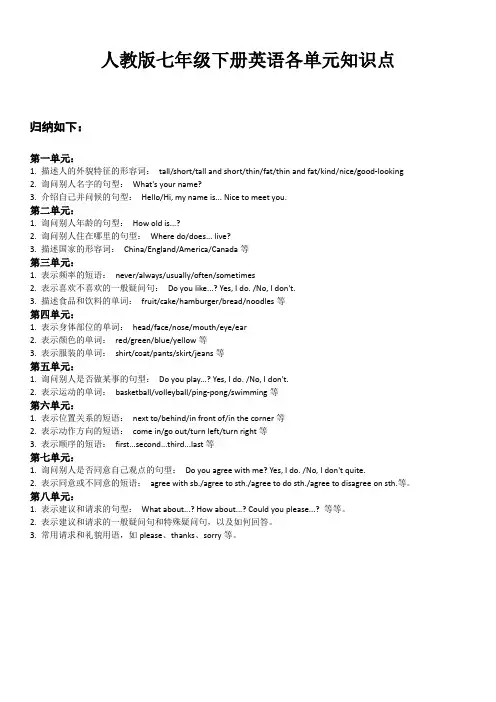
人教版七年级下册英语各单元知识点归纳如下:第一单元:1. 描述人的外貌特征的形容词:tall/short/tall and short/thin/fat/thin and fat/kind/nice/good-looking2. 询问别人名字的句型:What's your name?3. 介绍自己并问候的句型:Hello/Hi, my name is... Nice to meet you.第二单元:1. 询问别人年龄的句型:How old is...?2. 询问别人住在哪里的句型:Where do/does... live?3. 描述国家的形容词:China/England/America/Canada等第三单元:1. 表示频率的短语:never/always/usually/often/sometimes2. 表示喜欢不喜欢的一般疑问句:Do you like...? Yes, I do. /No, I don't.3. 描述食品和饮料的单词:fruit/cake/hamburger/bread/noodles等第四单元:1. 表示身体部位的单词:head/face/nose/mouth/eye/ear2. 表示颜色的单词:red/green/blue/yellow等3. 表示服装的单词:shirt/coat/pants/skirt/jeans等第五单元:1. 询问别人是否做某事的句型:Do you play...? Yes, I do. /No, I don't.2. 表示运动的单词:basketball/volleyball/ping-pong/swimming等第六单元:1. 表示位置关系的短语:next to/behind/in front of/in the corner等2. 表示动作方向的短语:come in/go out/turn left/turn right等3. 表示顺序的短语:st等第七单元:1. 询问别人是否同意自己观点的句型:Do you agree with me? Yes, I do. /No, I don't quite.2. 表示同意或不同意的短语:agree with sb./agree to sth./agree to do sth./agree to disagree on sth.等。
人教版七年级下册英语知识点复习(完整版)
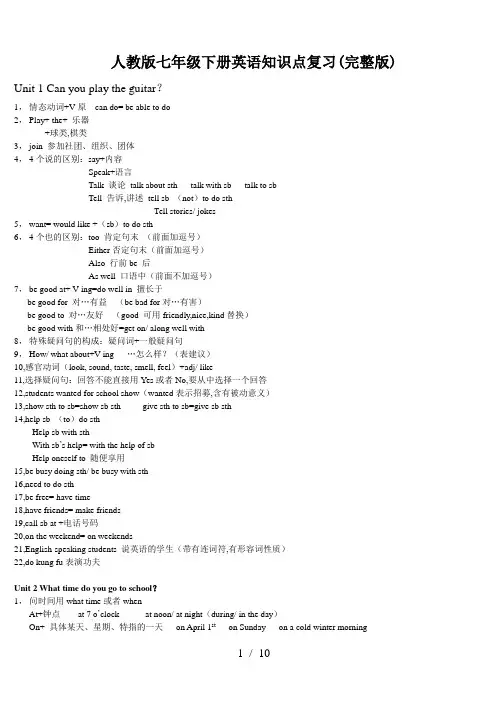
人教版七年级下册英语知识点复习(完整版) Unit 1 Can you play the guitar?1,情态动词+V原can do= be able to do2,Play+ the+ 乐器+球类,棋类3,join 参加社团、组织、团体4,4个说的区别:say+内容Speak+语言Talk 谈论talk about sth talk with sb talk to sbTell 告诉,讲述tell sb (not)to do sthTell stories/ jokes5,want= would like +(sb)to do sth6,4个也的区别:too 肯定句末(前面加逗号)Either否定句末(前面加逗号)Also 行前be 后As well 口语中(前面不加逗号)7,be good at+ V-ing=do well in 擅长于be good for 对…有益(be bad for对…有害)be good to 对…友好(good 可用friendly,nice,kind替换)be good with和…相处好=get on/ along well with8,特殊疑问句的构成:疑问词+一般疑问句9,How/ what about+V-ing …怎么样?(表建议)10,感官动词(look, sound, taste, smell, feel)+adj/ like11,选择疑问句:回答不能直接用Yes或者No,要从中选择一个回答12,students wanted for school show(wanted表示招募,含有被动意义)13,show sth to sb=show sb sth give sth to sb=give sb sth14,help sb (to)do sthHelp sb with sthWith sb’s help= with the help of sbHelp oneself to 随便享用15,be busy doing sth/ be busy with sth16,need to do sth17,be free= have time18,have friends= make friends19,call sb at +电话号码20,on the weekend= on weekends21,English-speaking students 说英语的学生(带有连词符,有形容词性质)22,do kung fu表演功夫Unit 2 What time do you go to school?1,问时间用what time或者whenAt+钟点at 7 o’clock at noon/ at night(during/ in the day)On+ 具体某天、星期、特指的一天on April 1st on Sunday on a cold winter morningIn +年、月、上午、下午、晚上2,时间读法:顺读法逆读法:分钟≤30用past five past eight(8:05)half past eight(8:30)分钟>30用to a quarter to ten(9:45)整点用…o’clock 7 o’clock(7:00)3,3个穿的区别:wear 表状态,接服装、手套、眼镜、香水等Put on 表动作,接服装Dress 表动作,接sb/ oneself get dressed穿衣3,感叹句:How+adj+主谓!How+adj+a/an +n单+主谓!What+ a/an +adj+ n单+主谓!What+ adj+ n复/ 不可数+主谓!4,from…to…5,be/ arrive late for6,频度副词(行前be 后)Always usually often sometimes seldom hardly never7,一段时间前面要用介词for for half an hour for five minutes8,eat/ have…for breakfast/ lunch/ dinner/ supper9,either…or10,a lot of=lots of11,it is +adj+for sb +to do sth (adj修饰to do sth)It is important for me to learn English.it is +adj+of sb +to do sth (adj修饰sb)It is kind/ friendly/ nice of you to help me.Unit 3 How do you get to school?1,疑问词How 如何(方式)how long 多长(时间)答语常用“(For/ about +)时间段”how far多远(距离)答语常用“(It’s +)数词 +miles/ meters/ kilometers”how often多久一次(频率)答语常用“Always/ often/ every day/…”或“次数+时间”等表频率的状语How soon多快,多久以后,常用在将来时中。
新人教版英语七年级下册1-12单元知识点归纳
Unit 1 Can you play the guitar?语言点梳理一、语法:情态动词:有一定意义,表示说话人的语气或情态,但不能单独作谓语,只能和其他动词原形一起构成谓语,没有人称和数的变化。
否定形式是在情态动词后面加上not。
变一般疑问句要把情态动词提到句子的开头,即:情态动词+主语+动词原形+其他?1.肯定句:He/She/I/We/They/You/Tom+情态动词can+动词原形.2.否定句:He/She/I/We/They/You/Tom+情态动词can+not+动词原形3.一般疑问句:情态动词can+ He/She/I/We/They/You/Tom+动词原形?Yes,主语+can./No,主语+ can’t.1)表示能力,“会;能”。
eg: Can you dance? 你会跳舞吗?2)表示请求或许可,“可以”。
eg: Can I ask you a question? 我可以问你一个问题吗?1. play the guitar/piano/violin/drums弹吉他/钢琴/小提琴/敲鼓play chess下象棋 play sports 做运动play soccer/basketball踢足球、打篮球(乐器名称前加the,球类名称前不加the)2. join the art club加入艺术俱乐部/swimming club游泳俱乐部sports club运动俱乐部/story telling club讲故事俱乐部English club/ art club/ music clubjoin v.参加,加入指加入某个团体,组织,群体,并成为其中的一员。
What club do you want to join ?你想加入什么俱乐部?I want to join the swimming club.=I want to be in the swimming club.take part in 参加,加入某项活动,并在其中其积极作用。
人教版英语七年级下册Units1-4知识点总结
人教版英语七年级下册Units1-4单元知识点归纳总结Unit1Can you play the guitar?一、重点短语1.at the old people's home在敬老院2.be good at singing善于唱歌3.be good at swimming善于游泳4.be good at dancing跳舞5.be good with old people与老人相处得好6.be in our school music festival参加我们学校的音乐节e and show us来给我们展示一下e to the Students'Sports Center来学生运动中心9.do Chinese kung fu表演中国功夫10.English-speaking students说英语的学生11.help with sports在运动方面提供帮助12.in the music room在音乐室13.in the school music club在学校音乐俱乐部14.in the school show在学校汇演中15.join the swimming club加入游泳俱乐部16.like drawing/like to draw喜欢画画17.make friends with sb.和某人交朋友18.musicians wanted招聘音乐家19.need help to teach music需要帮助去教音乐20.on the weekend/on weekends(在)周末21.play chess下国际象棋22.play games with people与人玩游戏23.play the drums打鼓24.play the guitar弹吉他25.play the piano弹钢琴26.play the violin拉小提琴27.students wanted for the school show为学校演出招募学生28.tell stories讲故事29.the story telling club讲故事俱乐部30.talk to/with和某人谈话31.talk with sb.about sth.和某人谈论某事二、重点句型1.—Can you play the guitar or the violin?你会弹吉他还是拉小提琴?—I can play the guitar.我会弹吉他。
人教英语七年级下册知识点
人教英语七年级下册知识点人教英语七年级下册共分为六个单元,分别是“Unit 1 My School”,“Unit 2 This is my sister”,“Unit 3 Is this your pencil?”,“Unit 4 Where’s my backpack?”,“Unit 5 Do you have a soccer ball?”和“Unit 6 What’s your favorite subject?”。
以下将详细介绍每个单元内的知识点。
Unit 1 My School1. 学校设施的表达方法,如playground、canteen、library等。
2. 英语中询问地点的疑问句结构及肯定回答、否定回答,如“Where is the gym?”和“It’s not here.”。
3. 英语中表示归属关系的名词所有格的用法,如“My father's car is red.”。
Unit 2 This is my sister1. 家庭成员的称呼及表达方法,如mother、father、sister、brother等。
2. 英语中询问身份的疑问句结构及肯定回答、否定回答,如“Is she your sister?”和“Yes, she is.”。
3. 英语中表示所有物的物主代词的用法,如“her book”和“his pen”。
Unit 3 Is this your pencil?1. 学习询问和表达物品所有者的语句结构,如“Is this your pencil?”和“No, it’s not mine. It’s Jack’s.”。
2. 学习询问和表达物品的名称的疑问句结构及肯定回答、否定回答,如“Is this a pencil?”和“Yes, it is.”。
3. 学习数词和颜色词的表达方法,如“two, three, blue, red”等。
Unit 4 Where’s my backpack?1. 学习问路及表述方向的语句结构,如“Excuse me, where is the post office?”和“Go straight and turn left.”。
人教版七年级英语下学期期末总复习重点知识汇总-(共64张PPT)
…To do/doing 两种用法பைடு நூலகம்
• find/see/ sb. do sth. → 观看/看见某人做某事 I saw you pick an apple just now. • find/see/sb. doing sth. → 观看/看见某人正在做某事 I saw you playing basketball with your classmates o
非谓语动词
• help sb. to do sth. →帮助某人做某事 Lucy often helps Lily to wash her clothes.
• help sb. do sth. →帮助某人做某事 He usually helps me learn English.
• help sb. with sth. →帮助某人做某事 I sometimes help my mother with the housework.
• take sb. to sp→带某人到某地 Mr. Wang took us to the Summer Palace last Sunday.
可跟双宾语的动词
• show sb. Sth→给某人看某物 Please show me the map. show sth. to sb. →把某物给某人看 Please show the map to me.
• buy sb. sth. →为某人买某物 Mother bought me a bike.
• buy sth. for sb. →为某人买某物 Mother bought a bike for me.
• give sb. sth →把某物给某人 Jim gave me an English dictionary.
- 1、下载文档前请自行甄别文档内容的完整性,平台不提供额外的编辑、内容补充、找答案等附加服务。
- 2、"仅部分预览"的文档,不可在线预览部分如存在完整性等问题,可反馈申请退款(可完整预览的文档不适用该条件!)。
- 3、如文档侵犯您的权益,请联系客服反馈,我们会尽快为您处理(人工客服工作时间:9:00-18:30)。
2017年人教版七年级英语下册各单元知识点汇总Unit 1 Can you play the guitar ?1. can+动词原形,它不随主语和数而变化。
(1) 含有can的肯定句:主语+can+谓语动词的原形+其他。
e.g. He can play the guitar.(2) 变一般疑问句时,把can提前:Can+主语+动词原形+其他?e.g. Can he play the guitar?肯定回答:Yes主语+can。
否定回答:No,主语+can't.e.g. Yes, he can./ No, he cdn(3) 含有can的否定句:主语+can't+动词的原形+其他。
e.g. He can't play the guitar.⑷含有can的特殊疑问句:特殊疑问词+can+主语+动词原形+其他? e.g. What can he doin the club?2. join参加,加入,指加入党派,团体等组织。
join the army/party 参军、入党Join sb. “参加到某人中”join in (doing) sth. “加入做.... ,参加某个活动”join in=take part in + 活动, 比赛3. 说某种语言:speak+语言e.g. speak Chinese/English4. play+球、棋、牌;play + the+乐器。
5. 擅长于(做)什么:be good at +名词/动-ingbe good with善于应付,和….相处融洽be good for对….有益be good to 对• •好6. 帮助某人做某事:help sb. (to ) do sth.在某方面帮助某人:help sb. with sth.7. 想要做某事:want to do sth想要某人做某事:want sb. to do sth.需要某人/时间做某事:need sb./some time to do sth.叫某人做某事:ask sb. to do sth.教某人做某事:teach sb. to do sth.让某人做某事:let sb. do sth.8. ---What club do you want to join ?---1 want to join the chess club and the basketball club.9. ---What club does Tom want to join?---He wants to join the swimming club .10. He can't play the violin or the piano.Can you help kids with swimming?11. ---Why do you want to join the English club?---Because I want to learn Englishwell.12. go for a swim=go swimming 去游泳13. show sb. sth.=show sth. to sbll 示某物给某人看Please show some pictures to me.=Please show me some pictures.14. talk to/with sb.和••交谈;talk about 谈论某事15. 交朋友make friends16. 在周末:on the weekendon weekends/at weekendsUnit 2 What time do you go to school ?1、what time和when引导的特殊疑问句。
对时间提问用what time,也可以用when。
询问钟点时用what time,询问日期、月份、年份时用when。
询问做某事的时间时,两者可以互换。
其他询问时间的句子:What's the time? =What time is it狈在几点了?时刻表达法:顺读法和逆读法。
(1) 顺读法:“钟点+分钟”直接读数字。
(2) 逆读法:借助介词past或to表示,要先说分再说钟点。
A.当分钟不超过30分钟时(包括30分钟),即<或=30,用past表示。
其结构为:“分钟+past+整点”意为“几点过几分”。
B.当超过30分钟时,即>30,用to表示。
译成“差”,差几分钟到几点。
C.当分钟为30分钟用half表示,当分钟为15分钟用a quarter。
2. always 总是>usually 通常>often 常常>sometimes 有时3. watch+TV (电视)、球赛“观看,观赏”,特指长时间注视。
see+电影、医生;“看见”,强调看的结果;look “看”,强调看的动作,look后接宾语时要用介词at。
read即刊、杂志“阅读”4.listen to + 宾语listen to music 听音乐5. take a shower "洗淋浴”6. eat breakfast 吃早餐吃一顿丰盛的早餐eat a good breakfast7. go to +地点名词如:go to schoolgo+地点副词省略to如:go home8. I can sing and dancel. ----------------------------注意把and换为orI can't sing or dance. ___________ _____1 r9. 起床get up 穿衣服get dressed 刷牙brush teeth10. toothbrush 牙刷;广播节目radio show;广播电台radio station散步 take a walk/go for a walkUnit 3 How do you get to school?一、重点短语1. get to school 到校2.take the subway 乘地铁3. take the train坐火车4.leave for… 动身去某地leave some place for some placed开某地去某地5. ......................... take…to••把带到6. most students大多数学生7. from- to••从... 到.... 8.ride bikes/a bike 骑自行车9. take the train to school 乘火车去上学10. go to school by boat 乘船去上学11.on the school bus乘坐校车12.be different from 和...不同13.one 11-year- old boy 一个岁大的男孩14.两者之间between-and.. 汽车旅程bus ride火车旅程train ride 地铁旅程subway ride每天every day 实现,成为现实come true二、重点知识详解1. take +a/an/the+表示交通工具的名词,乘……去某地,是动词短语,在句中作谓语。
He takes the train to Beijing.take the subway^地铁take a walk 散步take a shower 洗淋浴take a rest休息一会take a seat 坐下take some medicine吃药2. by+表示交通工具的单数名词或on/in+ a/an/the/ones+表示交通工具的单数名词,是介词短语作方式状语。
I get to school by bike. = I get to school on my bike.3. walk/ride/drive/fly+to+地点名词,步行/骑自行车/开车/坐飞机去某地;表示乘交通工具方式可以互换表达相同的意义:take the bus to schoo=l go to school by bus=go to school on a busdrive a car to work=go to work by car=go to work in a carfly to shanghai=go to shanghai by plane/air=take the/a plane to shangha=go to shanghai on a/the plane.4. get表示“到达”,后接名词需加to,接地点副词不加to.reach给示到达,是及物动词,其后直接接宾语。
arrive in+大地点arrive at +小地点后接副词不需介词。
5. It takes sb. some money/time to do st花费某人时间/钱做某事sb. pay some money for sth某人为某物花费多少钱sb. spend some time/money on sthK人在做某事或某物上花费时间/钱sb. spend some time/ money (in)doing sth.sth. cost sb. some moneyft物花费某人多少钱6. How far is it from A to B?=How far is B from A?答语有两种:(1) It & ・ meters/miles/kilometers(away府米/英里/千米(远)(2) It s about ten minutes walk/ ride.约有十分钟步行/骑车的路程。
7. have to后加动原,侧重客观的需要,有“不得不,被迫”之意,有多种时态形式,否定式为don't have to (needHt)意为“不必”。
must侧重于说话者的主观看法,认为有必要或有义务做某事,只有现在时一种形式,否定式must't意为“一定不要,不允许,禁止”反意词为“needn't”或don't have to/ doesrit have too8. dream of /about sb. /sth#见某人、某物dream of/about doing sth梦想做某事9. be afraid of sb./sth.害怕某人、某物doing sth.害怕做某事be afraid to do sth害怕做某事10. be like 像…look like 看起来像••- like to do/doing sth.11. what do you think of ・ .? = how do you like -.?认为••怎么样?12. It is +adj. + for sb.to do sth.of sb. 当表示事物特征时,如difficult, easy .important 等,用介词for;当表示人物品质时,如good, nice, kind等,用介词of.e.g. It is difficult for you to do math homework.e.g. It is kind of you to dress my sister every morning.三、语法归纳(一)how引导的特殊疑问句how引导的特殊疑问句提问交通方式,其答语分四种情况:a. take a/an/the咬通工具(单数)to地点b. 动词walk/ride/fly/drive+to+ 地点地点副词,省toc. by+交通工具(单数)d. on/in+限定词+交通工具how far用来提问距离,多远,其答语分为两种:(1)用长度单位表示:It is five kilometers.(2)用时间表示:It's twenty minutes' walk.how long用来提问时间,意为多久回答常用“ for+段时”。
